Temple and shrine rituals in Japan

When visiting (Buddhist) temples or (Shinto) shrines in Japan, there are a couple of rituals that will stand out to you. In this article I will explain three of the most apparent rituals in Japanese temples and shrines.
In general the etiquette is to behave calmly and. respectfully. You can show your respect by throwing a coin into the offering box and by making a prayer in front of a statue. If you want to attract the Kami’s (Shinto god) attention, you bow deeply twice, clap your hands twice, bow deeply one more time and then pray. If there is a bell or a gong you can use that before praying.
You may also be asked to remove your shoes when entering the temple. Usually you can leave your shoes at the shelves, or carry them with you in a plastic bag. Make sure you wear nice socks (no holes) and remove your hat.
When visiting a shrine you are not supposed to be sick, mourning or have an open wound as these are signs of impurity.
At most temples and shrines you are allowed to take pictures, but watch the signs!
Then there are some outstanding rituals at temples and shrines in Japan that might require further explanation.
1. Water cleansing
The first ritual is the one you will find immediately as you enter the temple grounds or a shrine in Japan. Upon arrival at the sacred grounds you will find a basin of water, a purification fountain, usually with a fountain or tap and several large spoon-like utensils, ladles. With this you need to cleanse yourself before going further into the temple.
With the water you are supposed to wash your mouth and then both of your hands, by pouring water from the ‘spoon’ unto your hands. You start the ritual by filling the ladle with fresh water and rinse both hands. Then pour water from the ladle unto one cupped hand, rinse your mouth and spit the water beside the fountain. You can not drink from the ladle or swallow the water. The rest of the water that is in your ladle, you can pour next to the basin.
After you have done that, you have finished the ritual and you may enter the temple or shrine.
Usually there are instructions placed next to the basin, so you can’t do it the wrong way.

2. Incense bathing
Another ritual you might encounter when visiting temples or shrines in Japan is the burning of incense. People will buy a bundle, light them, let it burn for a few seconds and then extinguish the flame by waving the bundle. Do not blow out the flame, since that is considered to be impure.
You may then put the incense into the incense burner and fan some smoke towards yourself. The smoke is believed to have a healing power. So if you are suffering from headache, you may fan some smoke towards your head.
When I was visiting the Sensō-Ji temple in Tokyo I noticed this father doing the incense bathing, but his daughter seemed not to be a very big fan.

3. Lucky charms: omikuji and ema
There are several typical Japanese good luck charms. And some of them you can find at temples and shrines, where they have become part of the ritual of visiting
The first of these are the paper good luck charms. They are called ‘omikuji’, or paper fortunes. These are strips of paper containing good or bad predictions. In return for a donation you can shake a vase filled with numbered straws. These straws have a number that corresponds with one of the paper strips. On this paper you can find a prediction. If the prediction is positive you may keep it. But if the prediction is bad, then you tie up the strip on a wire at the shrine. That way you leave the back luck behind.

Then the next ritual for good luck is the one with ‘ema’ or wooden wishing plaques. Walls filled with ema are a common sight at many shrines. People will write their dreams and wishes on them and then hope that the kami will hear them. During ceremonial fires the ema will be burned.

